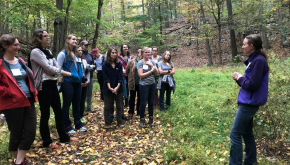
Featuring Pennsylvania's Women and their Woods Program (WOW)
Written by Leonora Pepper, Forest Stewards Guild 
Amanda Subjin of the Delaware Highlands Conservancy has a background in forest management and education. She coordinates Delaware Highlands Conservancy’s Women and their Woods (WOW) program, which serves women landowners in Pennsylvania and New York. This success story highlights her thoughts and insight on how the program was born, the needs it addresses, and some of its sweetest successes.
Women and their Woods
In 2008, Delaware Highlands Conservancy offered its first full-day program for women interested in learning from area professionals about forest management, botany, and avenues for conservation. Prior to that, the Conservancy was offering similar educational programs for landowners in general, in a four-county region of the upper Delaware watershed. Partnering with Grey Towers National Historic Site and the local Department of Conservation and Natural Resources (DCNR), the Conservancy was able to additionally take on outreach and education efforts specifically for women. The Conservancy identified a need for shared learning spaces for women land managers even though, at the time, many of them did not

Programs
Fall retreats are held over four days, with a very intensive agenda meant to serve as a crash course in forestry. Participants delve into stewardship topics including tree identification and mensuration, silviculture, how to perform water quality assessments, and even exercises in cognitive mapping to help landowners put on paper the most-valued aspects of their properties, as well as the challenges to managing them. The retreat also explores how to work with natural resource professionals, including how to interview individuals to identify those whose approaches align with the landowner’s goals.
Spring WOW workshops bring together graduates from the previous fall’s retreat to meet participants from previous years. While the fall retreats are more classroom-oriented, the spring workshops include a field tour and allow ample opportunity for women to build land-management experience through hands-on activities.
In 2012, the spring workshop took place over two days at a landowner’s property where participants shared lodging, the landowner cooked a big ham, and everyone else chipped in potluck style. The workshop curriculum covered chainsaw safety, personal protective equipment (PPE), hands-on use of an ATV with a logging arch for small-scale logging operations, and a hike covering the land-use history of the property. Participants also got to experience the use of prescribed fire for controlling invasives—in this case Japanese barberry. Lastly, the landowner had received funding for an edge planting bordering fields on her property, and workshop participants helped to install it with an eye to wildlife habitat improvement.
 Impetus
Impetus
When Amanda was an undergraduate student at Penn State, she reports “I was the only female student of Forest Management in the class of 2005. Being the only woman was a challenge, but it was not something that hindered me.” In taking on the coordination of the Women and their Woods program, Amanda wanted to encourage women landowners to be stronger voices in land stewardship.
From the start, the value in creating this kind of learning space was apparent to Amanda. “We would fill so much time with introductions and personal stories of the challenges on individuals’ land. The depth of conversation showed the need for women to have this space to discuss these things together.” Amanda believes that in swapping over-the-top stories and comparing scars from attempts to eradicate multiflora rose, these women are also strengthening their connection to their land.
 Needs addressed
Needs addressed
At the retreats, so many needs emerge from the discussions, it is difficult to identify just a few. A few are often in the forefront:
1. The ability to reach out to someone who has been down the road before.
The program seeks to address the need for a peer learning platform as women navigate the challenges and learning processes of land stewardship. For example, what professionals would someone who’s been down the path before recommend? The idea is not for the program teachers and coordinators to make specific recommendations, but rather to create a peer-to-peer learning network. Those who have interacted with natural resource professionals in the past can offer advice, for example, on questions to ask when vetting professionals.
Region-specific challenges
One challenge that comes up is a question of terminology. In reaching out to the target landowner demographics, it is important not to lose audiences over a question of word choice. In this region, the average acreage is very small, maybe six to nine acres. These often take the form of smaller parcels of woods, or small woodlands at the back of a farm. As a result, many women landowners don’t consider themselves “forestland owners”, but might be more likely to identify as “woodland owners”.
 Successes
SuccessesAs a weathered practitioner of women-specific land stewardship programming, Amanda offers three points of advice to others coordinating similar programs in other parts of the country:
- Reach out to existing local networks in the field of natural resource conservation. These can include watershed associations, woodland owner groups, and local conservation districts. Ask them if they see a specific need for women. Pose the same question to local professionals who may become future workshop presenters.
- Make sure your outreach is tailored to your target audience, as people won’t respond to outreach if they are not sure it is meant for them. In the context of WOW’s retreats and workshops, people often ask, “Do I need to own land to attend?” Depending on the region in which you work, there are many women who do not identify as woodland owners but nonetheless have a stake in land stewardship or love being involved in public lands. You may need to think about your branding and outreach approach, as these individuals may not turn out for programming branded for “woodland owners”.
- Facilitated discussion is one of the best resources available to zero in on specific needs that women-specific programming can address. Organize these conversations and learn everything you can from what is said!

